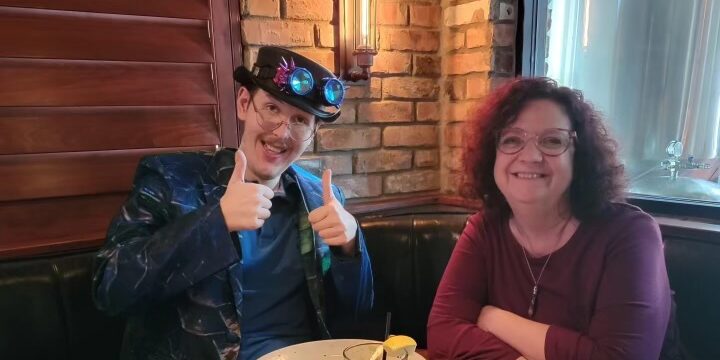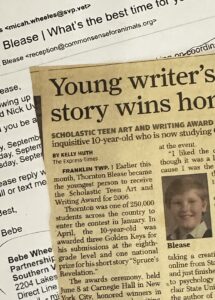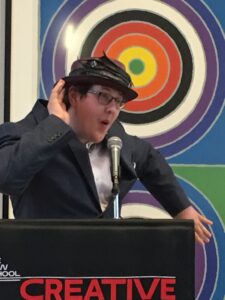
MDA Ambassador Guest Blog: Increasing Representation of Disabilities in Children’s Literature is My Life’s Goal
By Thornton Blease | Monday, September 9, 2024
5 Second Summary
MDA Ambassadors play an essential role in furthering MDA’s mission while representing and empowering the neuromuscular disease community. Quest Ambassador Guest Blog series provides a platform to share their personal stories, perspectives, and experience.
Thornton Blease wants to live in a world where horses and dragons roam free, and everyone can reach their fullest potential. He lives with myotonic muscular dystrophy and resides in Stewartsville, New Jersey. Thornton graduated from Sarah Lawrence College and earned an MFA in Writing for Children and Young Adults from The New School. He is represented by Joyce Sweeney of the Seymour Agency.

Thor was the youngest person to receive the Scholastic Teen Art and Writing Award for 2006
Writing and illustrating children’s books is one of the hardest professions I could have chosen. Only, I did not choose this career path, it chose me— it is a passion that could not be denied.
I have always loved words and pictures. When I was four, I started dictating poems and stories. By age five, I had already decided to become a writer. I attended Sarah Lawrence College, a well-known college for writing and creativity. After attending my first writing conference offered by SCBWI (Society of Children’s Writers and Illustrators) during my junior year of college, I knew I wanted to write books for kids. After that, I attended The New School and garnered an MFA in Writing for Children and Young Adults.
Children’s literature is probably the most authentic expression of humanity. It is a place where we can create unlimited ideas and improve the world. All children should have access to literature that reinforces their identities.
It is well known that children’s books are mirrors in which youth often identify with the characters found in the stories they read. All children prefer to emerge as characters with similar feelings and experiences. Books also serve as opportunities to learn about the world beyond their families and local communities. Children’s stories are powerful vehicles for self-approval and promoting empathy and acceptance of one another’s differences. Therefore, children’s literature must be inclusive. It needs to have diverse characters, including characters with disabilities.

Thor engaging with his audience
It is important to include characters with disabilities in children’s books, and they need to be portrayed in a positive, accurate, and realistic manner. Misrepresentation is detrimental to the self-esteem of those who may identify with the character and perpetuates stereotypes in society. Both sides of the same coin hinder one’s “looking-glass self.”
The looking-glass self is a psychological concept introduced in the early 1900s by Charles Horton Cooley. Cooley argued that humans develop their self-concept and identity through their experiences within the context of society. We understand ourselves through the lens of others’ perceptions. The looking-glass self develops at an early age. Therefore, since societal judgment is important to self-judgment and self-esteem, the appearance of positive characters with disabilities in children’s literature is crucial.

Thor showcasing his awards
Reflecting on the books that I read and enjoyed as a child, I realized that I never saw kids in those books who represented me. Disabilities seem to be “erased” from children’s book characters and their worlds. Therefore, my goal is to make sure muscular dystrophy, in general, and myotonic dystrophy, in particular, are represented.
Authors are responsible for handling sensitive topics for children’s books, including disabilities. This does not mean authors should avoid sensitive topics, but they should be presented positively, with equality as its beacon. Children live in the real world, and there is a need for quality books on all issues in that world.
Recently, there has been a focus on portraying individuals with disabilities. However, despite the many initiatives to make children’s books more diverse instead of only featuring able-bodied characters, disability representation is not common in children’s books. And it is even rarer to find those written by writers with a disability. Only 3.4% of children’s books have main characters with a disability, while almost 30% of society live with a disability.
The writers best able to write authentically on the subject are those who live with a disability themselves, which is one of the reasons I focus on characters with disabilities in my Picture Books, Chapter Books, Middle Grade books, and Graphic Novels.

Thor (and another) pose with Babymouse
Authenticity is one of the hardest components of writing. It is the hardest factor for those writing for children. Even more than adults, kids see through a story written without authenticity. As an adult writing for children, I can harvest memories and feelings, but understanding them and putting them on paper takes many different approaches. I worry that words that seem right might not resonate with a younger audience. With many possibilities of what and how to write my memories and experiences into a fictional world, I have to consider which approach, which word, and which sentence is the best approach to build a fictitious world. And I have to ask myself, “What is the best way to weave a creative tapestry for others to understand while also focusing on authenticity and inclusion?”
While difficult, writing gives meaning to my life and helps me understand our often-difficult world. Even when I was young, this was true. Before I could put pen to paper, I had to get my stories and poems out of my head. It was very cathartic. Thus, I would write even if it wasn’t my profession.
As writing helps me comprehend our world, I am convinced that reading books, more than any other form of communication, helps kids understand what is happening around them. Children’s literature is often perceived as simple and entertaining. However, books for children are meaningful outlets that reflect society and cultural norms. They are powerful tools that shape new ideas and have become an avenue for exploring diversity. My passion is crafting an intriguing story about characters who have exciting adventures and who also just happen to have disabilities.
Next Steps and Useful Resources
- For more information about the signs and symptoms of Myotonic dystrophy (DM), as well an overview of diagnosis and treatment concerns, an in-depth review can be found here.
- To learn more about MDA’s Advocacy program, visit here.
- To learn more about MDA’s Young Adult Programs, visit here.
- MDA’s Resource Center provides support, guidance, and resources for patients and families. Contact the MDA Resource Center at 1-833-ASK-MDA1 or ResourceCenter@mdausa.org
- Stay up-to-date on Quest content! Subscribe to Quest Magazine and Newsletter.
TAGS: Ambassador Guest Blog, Ambassadors, College, Community, Young Adults
TYPE: Blog Post
Disclaimer: No content on this site should ever be used as a substitute for direct medical advice from your doctor or other qualified clinician.




